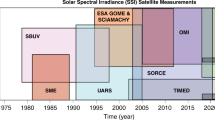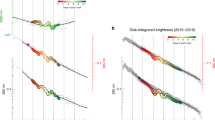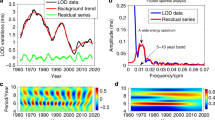Abstract
Observations of the Sun with a Danjon-type visual astrolabe have been recorded since 1975 at the CERGA Observatory. The primary goal of these observations is to determine the orbital elements of the Earth around the Sun. However, they also provide very good quality, homogeneous values of the solar diameter. The working principle of the astrolabe, which relies on the method of equal elevations1, has been described elsewhere2. The diameter value is obtained from the difference between the zenith distances of the solar centres corresponding to the instances of successive limbs crossing the same almucantar. The solar diameters are obtained up to 16 times per day. The heliographic latitude of the observed points varies throughout the day and changes with the seasons. In the present study, we have discarded the data taken at zenith distances >60° because of their lower quality on average. We consider then all the retained measurements on equal footing. The existence of a long period, ∼1,000 days, in the variation of the solar diameter has already been reported3. The low-frequency domain of the power spectrum deserved a more detailed analysis which the more recent data permit. Here, we present this analysis, which reveals several previously undetected periodicities.
This is a preview of subscription content, access via your institution
Access options
Subscribe to this journal
Receive 51 print issues and online access
$199.00 per year
only $3.90 per issue
Buy this article
- Purchase on Springer Link
- Instant access to full article PDF
Prices may be subject to local taxes which are calculated during checkout
Similar content being viewed by others
References
Debarbat, S. & Guinot, B. La Méthode des Hauteurs Egales en Astronomie (Gordon and Breach, Paris, 1978).
Laclare, F., Demarcq, J. & Chollet, F. C. r. hebd. Séanc. Acad. Sci., Paris 291B, 189–192 (1980).
Laclare, F. Austr. Astrophys. 125, 200–203 (1983).
Delache, P. & Scherrer, P. H. Nature 306, 651–653 (1983).
Delache, P. Mem. Soc. Astr. It. 55, 75–82 (1984).
Wolff, C. L. Astrophys. J. 264, 667–676 (1983).
Rieger, E. et al. Nature 312, 623–625 (1984).
Muller, R. & Roudier, T. in The Hydromagnetics of the Sun, Noordwijkerhout, The Netherlands, 51–54 (European Space Agency, Paris, 1984).
Jagdev Singh & Prabhu, T. P. Sol. Phys. 97, 203–212 (1985).
Hughes, V. A. & Kesteven, M. J. L. Sol. Phys. 71, 254–268 (1981).
Haubold, H. J. & Geth, E. Astr. Nach. 304, 299–304 (1983).
Sakurai, K. Nature 278, 146–148 (1979).
Author information
Authors and Affiliations
Rights and permissions
About this article
Cite this article
Delache, P., Laclare, F. & Sadsaoud, H. Long period oscillations in solar diameter measurements. Nature 317, 416–418 (1985). https://doi.org/10.1038/317416a0
Received:
Accepted:
Issue Date:
DOI: https://doi.org/10.1038/317416a0
This article is cited by
-
Rossby Waves in Astrophysics
Space Science Reviews (2021)
-
The Ten-Rotation Quasi-periodicity in Sunspot Areas
Solar Physics (2014)
-
On Short-Term Periodicity of the Solar Radius Measurements
Solar Physics (2011)
-
Comparison of long-term trend of solar radius with sunspot activity and flare index
Astrophysics and Space Science (2011)
-
Short-Term Periodicities in Sunspot Activity and Flare Index Data during Solar Cycle 23
Solar Physics (2009)
Comments
By submitting a comment you agree to abide by our Terms and Community Guidelines. If you find something abusive or that does not comply with our terms or guidelines please flag it as inappropriate.



